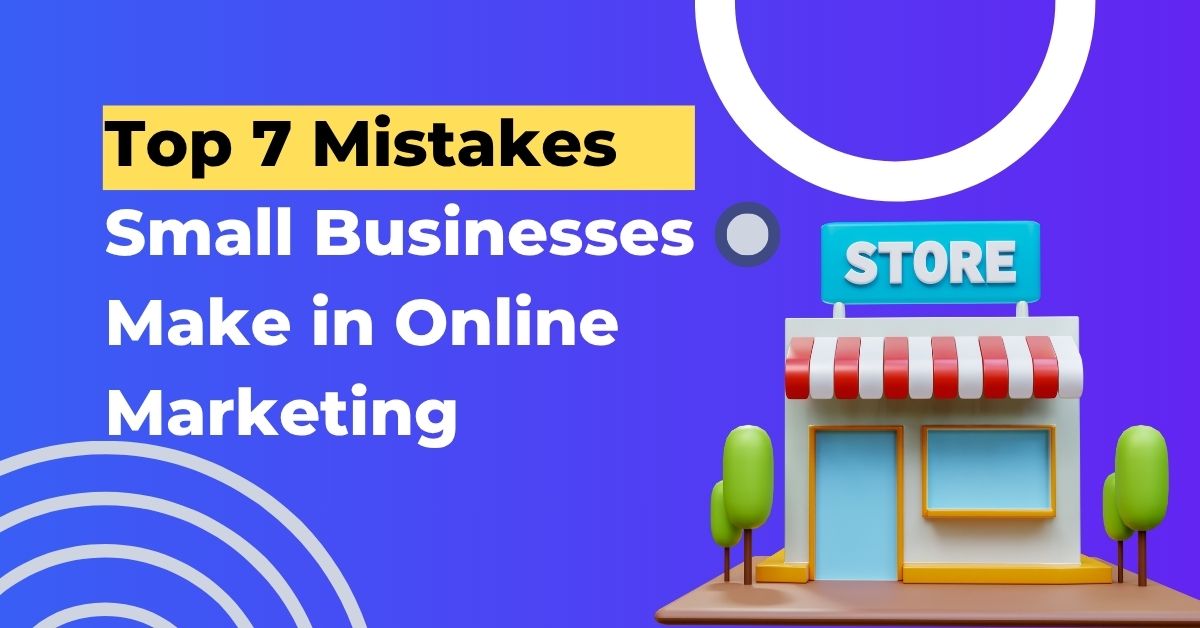The Top 7 Online Marketing Errors Small Businesses Make
Top 7 Mistakes Small Businesses Make in Online Marketing
The Significance of Internet Marketing for Small Businesses
Let’s face it: you will already be ten steps behind your competitors if your company isn’t online by 2025. Consumers are constantly clicking, scrolling, and searching on Google. Therefore, your brand must appear at the right time and in the correct location. Online marketing is now essential to your success and cannot be ignored.
1. Lack of a clear objective or plan
A typical snare for small companies? Launching into marketing without a strategy.
Absence of a Specific Goal
Too many companies run Google Ads or boost Facebook posts without knowing what they want—more leads, sales, or website visits? Your marketing campaigns will be ineffective if you don’t know why you’re doing it.
Unthinkingly wasting money
Without objectives, success cannot be monitored. You may be spending ₹10,000 a month on advertisements without knowing if they are producing any results. That’s gambling, not marketing.
2. Inadequate Web Optimisation
Your online shopfront is your website. However, many companies treat it more like a static brochure than a dynamic sales tool.
Not Suitable for Mobile
If your website isn’t responsive, you’re losing out on potential customers, as over 70% of traffic comes from mobile devices.
Slow Loading Times Speed is essential; a 3-second lag significantly raises the bounce rate. People won’t even see your offers if your website takes a long time to load.
Absence of SEO Content
Beautiful shops tucked away in alleys are like pretty websites that don’t appear on Google. Search Engine Optimisation, or SEO, improves your website’s ranking and visibility.
3. Poor Social Media Management
Many small businesses believe that setting up a Facebook page is sufficient. It isn’t.
Making Random Posts
Low engagement is often the result of posting without a clear strategy, calendar, or established brand tone. Social media is about connecting, not just “being there.”
Absence of Genuine Engagement
Likes aren’t everything. Are you responding to comments? Engaging in dialogue? Telling tales of customers? People want more than just advertisements; they want interaction.
4. Disregarding Email Promotion
Despite being one of the most economical marketing tools, email is frequently disregarded.
Lack of a Follow-Up System
Did someone express interest in your offering? Fantastic. What follows, though? You will lose the lead if you don’t follow up with emails.
Typical Email Blasts
It is inefficient and lazy to send the same email to everyone. Divide your audience and tailor your message to meet the specific needs of each group.
5. Only Using Paid Advertising
Without a doubt, paid advertisements are effective. However, they shouldn’t be your sole strategy.
No Effort to Grow Organically
What happens when your budget runs out if all you’re paying for is visibility? For long-term exposure, consider investing in Google My Business, SEO, and content marketing.
Absence of Ad Optimisation
Budget burn occurs when Facebook or Google ads are run without conversion tracking or creative testing. To boost performance, utilize tools such as A/B testing and Facebook Pixel.
6. No tracking or analytics
What you don’t measure, you can’t improve.
No Meta Pixel or Google Analytics
It’s like driving without a blindfold when you don’t set up tracking tools. Install them to identify where you lose users, which pages are most effective, and which channels are most effective.
Disregarding the Information
Gathering data is insufficient; put it to use. Evaluate reports on a weekly basis and make adjustments as necessary.
7. Ignoring the importance of content marketing
The majority of small businesses underinvest in content despite its potential to increase authority and trust.
No articles or blogs
Blogs aren’t just for authors. A blog demonstrates your expertise, aids in SEO, and responds to consumer inquiries.
Absence of Visual Content
Posts that include pictures or videos receive significantly more interaction. Start utilizing whatever works best for your brand, such as infographics, reels, product videos, and testimonials.
________________________________________
How to Steer Clear of These Errors
1. Before spending, set clear goals.
Establish your marketing goals, target audience, and success criteria (e.g., a 20% website conversion rate, 100 leads per month).
2. Establish a Firm Basis
• Develop an SEO-optimized, responsive website • Configure analytics and tracking • Activate and enhance your Google My Business profile
3. Adhere to a monthly marketing strategy
Describe your email campaigns, advertisements, promotions, and content beforehand. To stay organized, consider using programs like Google Sheets, Trello, or Notion.
4. Balance Paid and Organic Marketing
on Facebook and Google Ads with natural initiatives, such as blogging, social media interaction, SEO, and referral marketing.
________________________________________
In conclusion
When done correctly, internet marketing can be very effective. Many small businesses waste time and money by jumping in without a plan. However, you can save money and create a solid, long-lasting online presence by avoiding these seven typical blunders.
Begin modestly. Maintain consistency. Monitor your progress. Additionally, since digital trends are ever-evolving, companies that adapt will succeed.
Frequently Asked Questions
1. Does starting an online marketing campaign require a large budget?
No. With free resources like social media, SEO, and Google My Business, you can start small. When you see traction, you can then move on to paid advertisements.
2. How crucial is it for small businesses to have a website?
It is necessary. Even while you’re asleep, a well-designed website increases sales, establishes your credibility, and makes it easier for customers to find you.
3. What is the best marketing channel for return on investment?
Your audience will determine this. Although the returns vary by industry and business type, SEO and email marketing typically provide high returns on investment.
4. Can I handle everything on my own?
Although you can begin alone, for long-term success, consider working with an agency or freelancer or utilizing time-saving automation tools.
5. How frequently should my content be updated?
Ideally, you should update your website content once a month, post on social media three to four times a week, and publish a blog post every one to two weeks.
Read More: Top 5 IT Automation Tools for Enhancing Business Efficiency
Author

